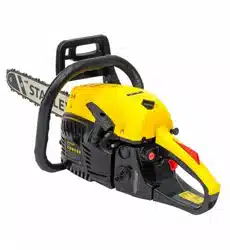Loading ...
Loading ...
Loading ...

15
Use a clamp (for example a saw stool) whenever
possible.
Only use the saw for wood or wooden objects.
Watch for foreign bodies such as nails or stones.
If they come into contact with the moving saw
chain they may be catapulted out and may also
damage the saw chain.
When cutting wood, the claw stop (5) must be
positioned firmly against the wood and when the
saw is started it must move into the wood. Hold
the saw using the front handle and pull the saw
upwards using the rear handle. The claw stop can
be used as a pivot point for this purpose. To reset the
position of the claw, press gently on the front handle and
pull the saw backwards slightly.
Now place the claw stop a little deeper and then
pull the handle upwards again.
For longitudinal cuts, the chainsaw must be positioned at
as flat an angle as possible. Since the claw stop cannot
be used in this case, take special care with these cuts.
Danger of recoil!
There is always a risk of recoil if the tip of the bar
touches wood or other objects. This makes the
chainsaw impossible to control and may lead to
it being catapulted with great force towards the
operator.
Whenever possible, always saw with the underside
of the bar since if you saw with the top of the bar, the
chainsaw will be catapulted towards the operator if the
chain jams.
Support yourself on the trunk whenever possible
when removing branches from a tree.
Special precautions for felling trees:
Felling trees is extremely dangerous and training
is required for this work. If you are unfamiliar with
this work, you should not attempt it. You must
receive training first.
Never attempt to fell trees whose diameter is greater
than the length of the guide bar.
A falling tree may also bring down other trees.
Always use twice the tree length as a danger area
(felling area). Take care also not to disturb
power and telephone cables.
Before starting to fell a tree, you must plan and
clear an escape route. The escape route must be
in the opposite direction to the expected felling
direction.
There must be no spectators, animals or obstacles
in the felling area.
If the saw jams in the tree, never attempt to free it
when the engine is running. Use wooden wedges
to free the saw.
Taking into account the centre of gravity of the
crown and the wind direction, calculate the felling
direction first. Ensure that the chainsaw is
running immediately before it comes into contact
with the wood. Saw a notch in the tree (A) in the
felling direction. This felling notch will guide the
tree and determine the direction in which it falls. Check
the felling direction again. In the event that you have to
correct the felling direction, recut the notch to extend it
to the full width of the trunk.
Shout “Timber”.
Now saw the felling cut (B) on the side of the tree
opposite the notch. Start this above the bottom
of the notch.
Place wedges in the felling cut promptly.
Leave a rupture strip (C). This acts as a hinge. If
you saw through the rupture strip, the tree will
fall out of control.
Never saw down trees, fell them using wedges.
Stand back when a tree falls. Check the crown
area. Wait until the crown stops shaking.
Never fell trees if you can no longer see all the
details in the felling area (because of rain, snow,
fog or twilight).
G
B
Loading ...
Loading ...
Loading ...
